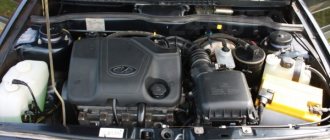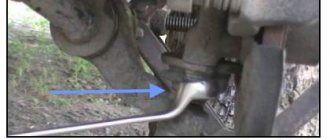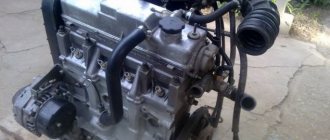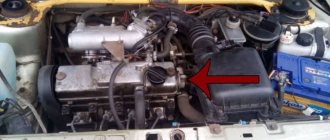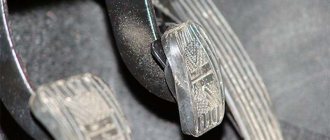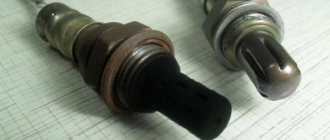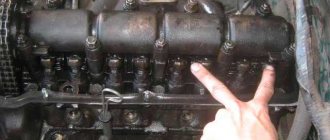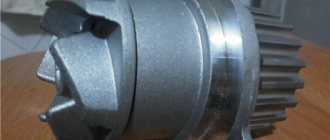13.11.2019
| (No votes) |
Issues discussed in the material:
- How are engine valves arranged?
- How to determine that it is the valves that are knocking
- What are the main causes of valve knocking?
- What to do if valves are knocking
An internal combustion engine is a complex mechanical device. During operation, it is exposed to high temperatures and vibration. Internal parts rotate and perform high-frequency translational movements. Each element of the internal combustion engine is subjected to heavy loads, so over time, abnormal sounds occur during engine operation. The article will tell you why valve knocking occurs in the engine and what to do in such a situation.
Signs of a burnt out valve, causes of burnout
The valves of an internal combustion engine are constantly subject to critical loads. Fuel flows through them and hot exhaust gases exit. In this situation, there is a high probability of breakdown.
If a valve burns out, the problem must be solved immediately. Otherwise, the engine will wear out.
First symptoms
It is quite simple to identify a burnt-out valve; the first sign is that the engine will start to stall. This is a violation in which the cylinders inside do not work properly due to poor combustion of the air-fuel mixture and a violation of the chamber seal. The exhaust gas does not push the piston with a burnt-out valve, but enters directly into the manifold. In this case, strong engine vibrations, popping noises in the muffler and characteristic noise appear. In this mode, the engine still produces few revolutions or none at all.
Due to engine tripping, fuel consumption increases significantly, since part of the gasoline is simply thrown into the air without performing useful work.
The loss of fuel affects other engine components, which is why it is important to identify burnout in the early stages so as not to expose other components to wear.
Burnout of the valve leads to the complete drying of the spark plugs, and smoke begins to come out of the breather. If the piston is broken, the smoke is colored bluish and the spark plugs are covered with a copious layer of oil.
You can determine the symptoms of a burnt valve by measuring the compression in the cylinder. After the procedure, a little oil is poured into the cylinder. If the readings have not changed, then the valve is faulty. However, measurement does not always determine valve failure. Poor compression may also indicate faulty piston rings.
Valve burnout is very similar to ignition problems. Novice mechanics are perplexed as to why the motor is vibrating, so they make a diagnosis themselves and move in the wrong direction. They buy a new distributor cap, wires, adjust the ignition, but to no avail. When you hear unwanted vibrations in the engine, the first thing you need to do is disassemble it and make sure that all elements are intact.
Causes
There are several reasons why valves can burn out:
- Manufacturing defects. The likelihood of deviations from the norm during the production of components is small, but still exists. Heterogeneity of the metal, defects in welding seams, microcracks are the first signs of defects.
- Critical temperatures. The operating temperature of the valves fluctuates around 650 °C. If the heat dissipation system is faulty, excessive overheating will cause the metal to quickly deteriorate.
- Poor quality gasoline. A lean fuel mixture leads to temperature spikes, which is even more damaging to the valves.
- Gas. Gas-powered engines are subject to greater loads than gasoline engines. Especially if the car is set to low gas supply. It is recommended to calibrate the valves every 10 - 15 thousand km.
Adviсe
Check the valve carefully when purchasing. Check the size standards and inspect the part for visible defects. Purchase spare parts only from certified points of sale from reputable manufacturers. The money saved on a cheap purchase will result in expensive repairs.
Check the valve clearances in the engine. Too short a distance is a common cause of overheating. Reduced clearance indicates wear of the valve seat. Install stiffer motor seats to prevent damage.
Thermal clearance table
Vehicle Intake (mm) Exhaust (mm)
| VAZ 2108-099, 2110-15 (8 valve) | 0.15-0.25 mm | 0.3-0.4 mm |
| VAZ 2101-07 | 0.15 mm | 0.15 mm |
| GAZ (402 engine) | 0.4-0.45 mm | 0.35-0.4 mm (1.4 valves), 0.4-0.45 mm (2.3 valves) |
Do not fill your car with low-quality fuel or lean gas in order to save money. Because of this, the engine loses some power and excessive gas consumption occurs. At the same time, regularly check the condition of the valves. Gas engines do not make as much noise when the valve is burnt out as gasoline engines.
When the first symptoms of a breakdown appear, it is better to contact a service center. Disassembling an engine with your own hands is a difficult process, especially with untrained hands. Experienced mechanics will quickly identify the problem and save you a lot of time.
ZnanieAvto.ru
Causes of the malfunction.
The symptoms of a burnt valve are to some extent similar to malfunctions that are completely unrelated to the car’s engine. That is why insufficiently experienced car owners can spend a lot of time and effort to repair and fix something that, in principle, was not broken. As a rule, they are the last to realize that the valve has failed.
But despite all their apparent insignificance, the valves perform a very important function - they allow fuel to enter the combustion chamber and release burnt gases. That is, they are constantly in an aggressive environment - under the influence of gases and high temperatures.
It is natural that the metal from which the valve is made gradually deteriorates - the valve burns out.
Most often, the valve “flies” in very old cars, as well as in budget cars, when producing which the automaker chose price over quality. However, car owners themselves, without even realizing it, often provoke/accelerate the process of valve burnout, for example, by filling their car with fuel that is not suitable for it. But this, as they say, is a topic for a completely different article.
Frequency of valve adjustment on VAZ-2115
But quite often there is a need to adjust them much earlier, due to many reasons.
This indicator is primarily due to the quality of domestic spare parts, which wear out quite quickly even under ideal operating conditions.
The appearance of a metallic knock in the upper part of a running engine, very similar to the sound of a sewing machine, will mean an increased gap between the camshaft cam and the valve tappet. This reason is caused by increased wear of the installed adjusting washer or camshaft cam. If such a sound occurs, it is necessary to adjust the valves as soon as possible, which will avoid major problems.
Much also depends on the quality of the engine oil, which has a significant impact on the degree of wear of power unit parts.
In this case, the need to adjust the valves occurs after a mileage of 30-35 thousand kilometers, and it is quite possible that it will only be necessary to measure the valve tappet clearances.
Why is it necessary to adjust valves?
The correct valve lifter clearance ensures stable operation of the power unit at full power. Valves are divided into two types:
Read more: Psychiatrist Queens certificate for traffic police
- Intake, the main task of which is timely opening for the entry of the fuel mixture into the combustion chamber and subsequent closing, ensuring the creation of the required compression ratio. Insufficient tappet clearance causes the tappets to open too early, resulting in fuel flowing in too early and also igniting early. Too large a gap ensures that the valve opens too late, causing fuel to enter and ignite in the combustion chamber too late. All this leads to insufficient power of the power unit and rapid burnout of the working surface of the valves.
The main causes of valve knocking
The causes of valve knocking are varied. Each of them needs to be discussed separately. Without exception, all internal combustion engines have a camshaft located on top. Thanks to the presence of pushers on this shaft, the valves operate. Let's determine the main reasons why these parts knock:
- Violation of the pusher-valve gap. At the factory, during assembly, the distances between the valves and rods are adjusted. If this value changes during operation, the valves begin to knock with a characteristic metallic sound. The noise is clearly audible even at idle.
- Saving on fuel. There is a situation when a car owner saves by purchasing low-quality fuel. The consequences of such behavior are dire. Fuel that is not suitable for the engine type causes detonation and, as a result, damage to the valves.
- Low oil pressure during acceleration. Sometimes valve knocking appears only when you press the gas pedal while driving. The reason for this is low oil pressure in the engine lubrication system, which prevents it from increasing speed.
- If the timing belt is not installed accurately or is out of position, it can also cause a knocking noise.
Very often valves knock for a completely banal reason - wear during operation. That is, they simply need to be replaced due to resource depletion.
Why do valves burn out?
In fact, there are many reasons. For those engines where the manufacturer recommended periodic valve adjustment, this problem occurs due to the incorrect adjustment of the thermal clearances. On engines where the clearance adjustment process is performed automatically, hydraulic compensators may fail - as a result, the valve simply burns out.
There are several most popular reasons, the result of which is the same - the valve has burned out. So, the first reason is that the parts are very tightly clamped. Next, the valve guide is in a state of severe wear. It is also common to see wear on the rod. And one more reason is that the engine runs on a lean mixture; owners of gas-powered cars especially often face the problem of burnout. Most often, exhaust elements burn out. They heat up to significantly higher temperatures than the intake ones. The intake valve is cooled during operation by a mixture of fuel and air.
The operating temperatures of the exhaust elements are about 400 degrees. This valve, unlike the intake valve, is not cooled in any way; in addition, it is additionally heated due to exhaust gases. Next, these valves are heated to approximately 650 degrees.
Causes of valve knocking on a cold or hot engine
During diagnostics, it is recommended to record the engine temperature at which valve knocking occurs. In some situations, noise occurs in only one thermal state of the engine. This additional information can be very helpful for a more accurate diagnosis.
Valve knocking on a cold engine
One cause for concern is engine noise during warm-up. That is, the knocking noise under the valve covers is present only until it reaches operating temperature. Experts have a fairly accurate explanation of this process. The fact is that in a car with significant mileage, all components and assemblies, especially the engine, have a high percentage of wear. Wear manifests itself in the form of increased gaps between parts compared to the factory ones. It is these gaps that cause noise when operating in a cold state. As the metal heats up, the metal expands, the gaps become smaller, and the knocking goes away.
A knock on a cold engine can occur when the clearance in the pusher-cam pair is not normal. In a warm state, this gap is still not critical, but in a cold state it already manifests itself as an abnormal sound.
We recommend
“Oil is leaving the engine: we understand consumption rates and problems” Read more
The above information does not mean at all that if the engine knocks only when cold, then the driver should not react. Quite the contrary, this is evidence of dangerous processes that have already begun inside the engine. In addition to valves, crankshaft bearings - connecting rod and main bearings - can be a source of noise. If this is the case, the problem needs to be fixed very quickly.
Valve knocking on a hot engine
The engine may knock when warm. This phenomenon is caused by several reasons. Moreover, the knock either appears when the internal combustion engine is heated to a certain temperature, or persists from the moment of startup.
Let's list the reasons:
- The camshaft is attached to the “bed” using a special bolt. If this bolt is unscrewed during operation or is poorly tightened after repair, a knocking sound from the camshaft will appear.
- Lack of oil can also cause valve knocking. Especially when the engine is hot.
- The oil filter is clogged and cannot fully pass the oil flow through it.
Failure of hydraulic compensators is also a source of noise. Some causes of knocking can be eliminated by routine adjustment of a particular unit. Others require repairs in a professional workshop, which are labor-intensive and financially expensive.
Valve knocking during acceleration
The problem of a knocking engine can be encountered in the most inopportune place, for example on the road. It won’t be possible to solve it right on the side of the road. The first step in case of unexpected knocking is to check the engine oil level. The relationship between a lack of oil and damage to engine parts is known to many drivers. It often happens that when the oil is replenished, the knocking goes away.
It is also a good idea to pay attention to other features of the operation of the power unit: determine whether the knocking of valves increases with engine load and evaluate the intensity of the increase. If the answers to these questions are positive, suspicion falls on the crankshaft bearings. And this is where it’s worth stopping. Continuing to drive with such a malfunction is fraught with complete failure of the internal combustion engine.
After filling up fuel at a gas station with a bad reputation, you can also hear a knocking noise under the hood. If the sound fades quickly, you can move on. It also happens that they drive with a bang for tens of thousands of kilometers. This is acceptable as long as there is no change in sound. If the intensity of extraneous noise increases, it is better to stop moving.
If the valves knock when accelerating the car, there is only one way to solve the problem. To facilitate the operation of the gas distribution in the engine, it is necessary to adjust and clean the valves. Let's talk in more detail about this procedure.
Knock of valves and hydraulic compensators
In the automotive industry, the opinion has long been established about the exceptional reliability of the hydraulic compensator as a system for adjusting valve clearances. If all engine systems are in good condition, there is no need to worry about adjusting the clearances. The hydraulic compensator is designed simply - a plunger and a housing. It is installed between the valve and the cam on the camshaft. This device operates thanks to the pressure in the engine lubrication system. The cam presses the plunger and adjusts the clearance.
Let's consider the principle of operation of the hydraulic compensator in more detail:
- At the beginning of the cam movement cycle, the hydraulic compensator body moves downward, which leads to the alignment of its oil channel and a similar device in the head block. Oil fills the plunger, excess pressure pushes it out. The plunger occupies all possible space between the cam and the end of the valve stem. Thanks to the ball valve, the oil flow path from the housing is blocked. The thermal gap is eliminated, so further movement of the cam opens the valve.
- When the cam returns to its original position, the oil pressure becomes equal and the ball valve no longer prevents oil from flowing out. Excess lubricant leaves and a gap forms between the rod and the cam.
The cycle of these actions is repeated with each revolution of the cam mechanism. Motor oil serves as an efficient working fluid due to its low compression ratio. In addition, all elements of the cylinder head are lubricated. However, hydraulic compensators also have disadvantages. But today the mechanical engineering industry does not have a better solution. For correct operation of hydraulic compensators, a number of conditions must be met.
We list the most common malfunctions responsible for the occurrence of knocking in valves:
- Mechanical wear . A knocking noise may occur due to wear on the hydraulic compensators themselves. Typically these parts last 150–200 thousand km. This applies to both the cheapest and the most expensive and high-quality parts. To eliminate the cause of this knock, you simply need to replace the hydraulic compensators. Moreover, in case of repair, the entire set must be changed. If engine repair does not involve replacing them, then during assembly you need to put each in its place. This is a mandatory and very important requirement.
- Low quality or used oil . Here is another reason to change the oil according to the regulations. As engine oil operates, it becomes less viscous and more susceptible to compression. Therefore, at some point it cannot ensure the normal operation of hydraulic compensators. And, as a result, a knock appears.
- Clogged oil passages of the plunger or head . If you use a car for a long time without worrying about replacing the oil filter, the conductive channels become clogged. As a result, the oil pressure drops and the throughput of the channels decreases. There are situations so advanced that the hydraulic compensator plunger completely jams. Repair involves flushing the system, changing the oil and filter.
- Oil pressure also drops when the filter is clogged or the oil pump is severely worn.. If the pressure is low, the hydraulic compensator does not have enough oil to operate properly. The clearance on the valve cannot be removed. Therefore, every motorist needs to take care not only of replacing oil system consumables, but also of preventing and repairing the oil pump.
We recommend
“How to remove play in a car’s steering rack with your own hands” Read more
- If the car has insufficient oil level, parking at an angle can lead to an unpleasant situation . Air will enter the lubrication system. As a result, the compression ratio will decrease by a significant amount. To correct the situation, you will have to change the oil and get used to periodically monitoring its level.
Hydraulic compensators are an integral part of the lubrication system. All parts of this system are inextricably linked. Therefore, it is important to monitor the serviceability of the filter and pump, change the oil in a timely manner and monitor the operation of the timing belt. The most common cause of valve knocking is precisely a malfunction of the lubrication system. Timely maintenance and repair of system components will extend the life of hydraulic compensators and eliminate the problem of engine knocking.
How to adjust valve clearances VAZ-2114 8 valves
If on a VAZ-2114 1.5 or 1.6 the valves “knock” on eight valves, this indicates that the components need to be adjusted as quickly as possible. Unfortunately, not all car owners immediately begin to eliminate such a malfunction, which leads to more serious consequences. After all, if timely adjustments are not made, the engine power will decrease significantly, the valve will burn out, and the camshaft may become unbalanced. Don’t know how to properly adjust valve clearances on a VAZ-2114 8 valve? Then we recommend that you familiarize yourself with the information that will be presented below.
Setting the gap on the VAZ 2114
In our case, on a VAZ 2114 car, this procedure is performed in the second way, using adjusting washers and a special tool.
Firstly, you need to understand that correct adjustment on the VAZ 2114 can only be performed at an ambient temperature of 20 degrees Celsius, when the metal is at rest and is not subject to thermal expansion as on a warm engine. Secondly, for each specific car there is a table of the dimensions of the gaps with the camshaft cams raised.
For the fourteenth model the following dimensions are used:
- For intake valves - 0.2 mm with an indication error of 0.05 mm;
- For exhaust valves - 0.35 mm with an indication error of 0.05 mm.
Before making adjustments, cool the space under the hood; you can use an ordinary fan. After this, dismantle the valve cover, pipes, mounting clamps, and side protective casing of the timing belt. After unscrewing the nut securing the accelerator pedal cable, carefully disconnect it. To make work easier, remove the air filter housing assembly. Before dismantling, be sure to place wheel chocks under the wheels and engage neutral gear. The hand parking brake must also be set.
“Heat load” of intake and exhaust valves
I want to start with the fact that these engine elements are very heat-loaded parts. They are quite miniature, often the valve stem diameter is only 5 mm, and the temperature in the combustion chamber can reach 1500 - 2000 ° C (albeit for a short time, but still).
As I wrote above, the clearances at the intake and exhaust valves differ; usually at the exhaust they are much larger (by about 30%). For example (on the engines of Korean cars), the “exhaust” ones have a thermal gap of about - 0.2 mm, and on the “exhaust” ones - about - 0.3 mm.
But why are the gaps larger at the outlet? The thing is that the exhaust valves “suffer” more than the intake valves. After all, HOT exhaust gases are discharged through them, and accordingly, they heat up more - therefore they expand (elongate) also more.
Work order
Now the sequence of actions:
- We install the VAZ 2114 on a flat surface, the engine must cool completely so that there is no error in the measurements due to metal expansion;
- Remove the valve cover, as well as the side cover under which the timing belt is located. The surface under the lid must be wiped of oil. You should also carefully inspect the timing shaft for burrs, holes, and signs of significant wear. If there are any, the shaft will have to be replaced;
- We unscrew the spark plugs to make it much easier to turn the crankshaft in the future.
- We combine the mark on the camshaft drive gear with the protrusion on the cylinder head, that is, we set the TDC on the first cylinder. This can be done using a wrench, which we use to rotate the crankshaft by the pulley bolt. But some car enthusiasts do things a little differently - jack up the front wheel on the left and engage 4th gear. Then they simply rotate the wheel, and since the gear is engaged, this rotation will be transmitted through the transmission to the engine;
- After aligning the marks on the camshaft gear, strictly opposite the existing mark, we make another one with chalk. This will make future work somewhat easier.
- We use a feeler gauge to measure the gaps on valves 1 and 3 (you need to count from the camshaft gear. The 1st is exhaust, and the 3rd is intake);
- The gap on 1 valve should be 0.35 mm, but an error is allowed. That is, we take a feeler gauge 0.35 mm thick and insert it between the shaft cam and the adjusting washer. If the probe moves with little effort, then the gap is normal, but if the probe does not enter or is very loose, then adjustment is required. We do the same check on valve 3, but the gap on it should be 0.2 mm.
- The adjustment of the valves is carried out as follows: we attach the device for pressing the valves to the studs securing the cover. This device has a curved lever that we place between the cam and the washer. Using the handle of the device, we press on this lever, as a result of which it will press on the pusher. This device comes with a special clamp, which we place between the camshaft and the pusher. After releasing the handle, the latch will hold the valve in a squeezed state, while the washer will not be pinched and can be removed with tweezers.
- Let's look at an example of what kind of washer will need to be installed in order for the gap to be correct. For example, when checking the exhaust valve, it was found that it was not 0.35 mm, but 0.42 mm, that is, it was increased by 0.07 mm. Next, remove the washer that was installed. There should be a mark on it indicating its thickness (for example, 3.65 mm); if there is no such mark, then you will have to measure the thickness with a micrometer. Now we add to the thickness of the washer the value by which the gap is increased, in our case - 0.07 mm, as a result we get the value of the thickness of the washer for installation - 3.65 + 0.07 = 3.72 mm. But since a washer with such a thickness is not included in the kit, we install a new washer with a thickness as close as possible to the obtained value, that is, 3.7 mm. This is why an error of 0.05 mm is allowed.
- We install the washer of the required thickness in place with the size mark down (towards the pusher). Next, use the lever of the device to press the valve again and pull out the latch. This completes the adjustment.
- Next, the remaining valves are adjusted, but for this you need to know the order. After checking valves 1 and 3, turn the camshaft half a turn (for ease of installation, we made a mark on the gear in advance) and check valves 2 (intake) and 5 (exhaust). Then we turn it another half turn and adjust 6 (intake) and 8 (exhaust). To check the 4th (intake) and 7th (exhaust) valves, you still need to turn the camshaft half a turn once.
Read more: Kia Picanto does not turn the starter
After all the work, we replace the removed covers and are satisfied with the smooth operation of the timing belt and the engine as a whole.
The engine gas distribution mechanism on the VAZ-2115 car is an adjustable design, which means that it is periodically necessary to set the required valve clearance using adjusting washers. This procedure must be carried out at the slightest knock in the cylinder head or every 45 thousand kilometers.
How to eliminate valve knocking
If you start making strange knocking noises from the engine while driving, the first thing you need to do is make sure that the oil level in the engine is normal. When there is not enough oil, even a working pump will not be able to provide lubrication to all the necessary components. The average oil level is considered normal.
Next, you should carry out certain tests - see if there is valve knocking at idle, what happens when the engine is loaded and during acceleration of the car. Increased noise clearly indicates wear of the crankshaft bearings.
If a clattering sound appears after filling the fuel, you can safely assume that it is the culprit of the problem. Over time, this effect will pass and is not critically dangerous for the engine. However, it is better not to refuel at this gas station in the future.
What should be done to eliminate valve knocking? We discussed above that the internal combustion engine design uses two or four valves per cylinder. Valves are also divided into intake and exhaust. The motor operates at high temperatures. Therefore, metal parts predictably expand. As a result, the gap changes. If the valves are adjusted incorrectly, this can lead to rapid wear of the timing system. And the engine will significantly lose power. If the gap increases, the valves will not open fully. If the gap is too small, the valves and seats will burn.
If there are no hydraulic compensators in the car design, the valve clearances must be adjusted every 25 thousand kilometers. It would also be a good idea to clean these elements, because during operation carbon deposits form on their surface. As a result, the normal operation of the valves is disrupted. Thus, the conditions for stable operation of the car and normal fuel consumption are clean valves and adjusted clearance.
The thermal gap can be adjusted. Let's look at how to do this using a VAZ car. For tools, we will need open-end wrenches and a set of sockets. In addition, it is necessary to have a probe with a thickness of 0.15 mm. Next you need to do the following:
- With the gearbox in neutral, place chocks under the rear wheels.
- Allow the engine to cool to 20 degrees Celsius.
- Unscrew the bolts holding the valve cover. To do this you need a 10 key.
- The crankshaft pulley is set according to the marks. The camshaft mark should align with the arrow on the valve cover.
- Using a feeler gauge, adjust the clearances of the sixth and eighth valves. Traditionally, valves start counting from the radiator side.
- Turn the crankshaft half a turn.
- Then use a feeler gauge to adjust valves four and seven. Next, the crankshaft must be turned half a turn again.
- Set valve clearances number three and one.
- Then the second and fifth valves are adjusted.
At the end, you need to check again that all the gaps are set correctly. The feeler gauge should fit into the gap with a little friction, but without significant effort. It must be borne in mind that after tightening the locknuts, the gap will become smaller. It is strictly forbidden to leave the valve in a clamped state.
Self-adjustment does not always help eliminate knocking. If this happens, it is better to entrust further repairs to a service station. It is unlikely that you will be able to remove other causes of noise with your own hands. It is possible that, despite your efforts, you will not be able to set the valve clearances correctly.
An important clarification - knocking in both cold and hot engine states indicates serious malfunctions. If such a problem is detected, it is better not to postpone a visit to the service station. It is very easy to make mistakes during repairs, which will lead to worsening problems. That is why it is not at all recommended for beginners to repair valves themselves.
Determining valve burnout without removing the cylinder head
The first step is to determine which cylinder is not working. The testing methods are in many ways similar to diagnosing faulty spark plugs. To check, you should start the engine, after which, with the engine running at idle speed, you will need to remove the caps from the spark plugs one by one.
After removing each spark plug cap, you need to carefully monitor the idle speed and the overall stability of the engine. If the engine starts to rev more strongly or stall, then the cylinder from which the cap was removed is working. If after removing the cap the engine operation does not change or the speed changes only slightly, then the problem cylinder has been detected.
Then you need to unscrew the spark plug on the inoperative cylinder and replace it with a known good one, and also check the high-voltage armored wire of this cylinder for functionality. It would also be a good idea to check the ignition coil, etc. Subsequent starting of the engine will show whether the problem lies in the elements of the vehicle’s ignition system or whether further diagnostics are necessary.
If the nature of the engine’s operation does not change after installing the working spark plug, replacing the high-voltage wire and checking other components of the ignition system (the engine continues to rev), then there is a high probability of more serious breakdowns:
- timing valve burnout;
- CPG malfunctions;
Burnout of the valves means that compression in the cylinder is reduced due to a violation of the tightness of the combustion chamber (leakage during the fit of the intake or exhaust valve, destruction of the disc and/or valve seat). Wear of the cylinder-piston group and piston breakage also lead to low compression in the problem cylinder. Also, the cylinder may not work due to stuck or broken piston rings.
Now it is necessary to localize the malfunction, that is, to accurately determine the burnout of the valve or identify problems with the CPG. The most common way to determine burnt valves is to measure the compression in the cylinders.
Low compression clearly indicates a malfunction, but one caveat should be taken into account. It will not be possible to establish a burnt-out valve and rule out problems with the CPG only based on the compression indicator. The fact is that compression in the engine can decrease both as a result of a burnt-out valve, and due to broken piston rings, as well as a number of other defects. For this reason, in parallel with the compression measurement, additional engine diagnostics should be carried out.
- The easiest way to determine valve burnout after you have measured the compression in the cylinders is to pour several “cubes” of engine oil through the spark plug well. Then the compression must be measured again. An increase in compression in the cylinder after adding oil will indicate that an oil film has formed, acting as a “seal”. This phenomenon is typical in the case of piston wear. If the compression indicator has not changed, it means that the valve has burned out, since the oil in the cylinder in this case will not affect the compression in any way.
- Also, to determine whether the valves are burned out, you should inspect the spark plug on the problem cylinder. A clear sign of valve burnout is that the spark plug is completely dry, that is, it does not have a characteristic oil deposit. There may also be smoke or air coming out of the engine breather. The intensity of smoke production directly depends on the degree of wear of the CPG.
As for breakdowns that are associated with the piston, in this case the spark plug is covered with oil, and the appearance of bluish smoke can be observed from the breather. Note that oil on a candle is an indirect sign. Even if the spark plug is dry or covered with a slight soot, but smoke comes from the breather, then this symptom indicates problems with the piston or piston rings. On new engines with low mileage, there is a high probability that the piston rings are stuck.
Let us add that the appearance of engine oil that comes out through the breather also indicates a malfunction of the partitions between the piston rings. Taking into account the above, you can accurately determine why the compression in the engine has decreased, identify problems with the cylinder-piston group, or determine burnout of the timing valves.
Signs
The symptoms of a burnt valve coincide one-to-one with a sign of a malfunction in the ignition system. Therefore, very often inexperienced mechanics begin to repair the ignition. At the same time, they change the distributor cap, install new high-voltage wires, spark plugs, and turn on the ignition, but there is no result. The engine has been running every now and then and continues to do so. They, cursing the creators of cars, continue to look for the cause, without even realizing the true cause of the problem. Moreover, even those who guessed that the problem lies in the engine will only find out about the burnt-out valves after removing the cylinder head.
However, there is a way to diagnose this malfunction without disassembling the engine. The search for the cause must occur according to a certain algorithm:
- Ignition is checked
. Here you need to pay attention to the performance of the distributor, the correct ignition timing, and the integrity of the wires; - Identify the problem cylinder. They do this in the following way. One by one, they pull off the high-voltage caps from the spark plugs. If the cylinder is working, the engine will start to stall. The faulty one will not respond to such an action, and the operation of the engine will not change. This should be done carefully. The caps must be removed using insulated pliers;
- After this, compression is measured. Most likely, it will be slightly lower than the required 11 points. But this may be an indicator of both problems with the valves and a malfunction of the piston group.
Usually at this stage, car enthusiasts grab a set of keys and begin to enthusiastically rev up the engine. But there is a way to recognize the true cause of the malfunction without disassembling the engine. It is worth preparing the necessary parts and tools in advance.
When do you need to adjust the valves on a VAZ-2115: after how many km
The valve adjustment procedure involves adjusting the gap between the camshaft cam and the transverse edge of the valve stem. Moreover, each manufacturer of a particular vehicle determines its required value, called the “thermal gap” and intended to ensure that the valves close tightly at any engine temperature.
In this article we will consider the “thermal clearance” of valves on the VAZ 2114, or rather the technology for adjusting them.
Tools needed to perform valve adjustments.
- Set of adjusting washers.
- A set of feeler gauges for measuring valve clearances.
- Micrometer.
- Clamp for pusher springs.
- Specialist. tools: heads and keys measuring 8-13 mm.
Brief description of the procedure
Nowadays, any modern car, except electric ones, has an internal combustion engine with a gas distribution mechanism. A lot of parameters depend on the proper operation of this system. And they include fuel consumption, engine response, environmental characteristics and other equally important indicators. The normal function of the gas distribution mechanism is ensured by the correct adjustment of the gaps between the valve and its pusher.
If the gap is too large, the camshaft cam will hit the pusher plate with force, and all this will lead to serious damage to engine components and mechanisms. In addition, the valve will not fully open when needed, thereby blocking the movement of exhaust gases or the fuel-air mixture, depending on the type of valve. Intakes are responsible for the supply of fuel, exhausts are responsible for exhaust gases directed to the exhaust manifold.
On the contrary, if the valve is tightly clamped, then mechanical damage to engine parts will be less than if the gap is too large. But the engine operation itself will be much worse. It is for good engine performance that it is necessary to carefully adjust the valves on VAZ cars. This procedure is carried out in several ways. The first is that the pusher is moved under the influence of the nut on the rod. The second is the selection of gasket washers of the required thickness. The third is automatic, regulated by engine oil pressure into hydraulic compensators.
Combustion of the working mixture in spark-ignition engines
The progress of the combustion process can be judged from indicator diagrams that graphically show the change in pressure P in the cylinder depending on the angle φ of the crankshaft. The area of the indicator diagram is proportional to the work done during the combustion of the working mixture inside the cylinder in one cycle. If the ignition is turned off, then the pressure in the cylinder changes almost symmetrically with respect to the TDC when the crankshaft rotates. (lower curve). For normal engine operation, the ignition must be turned on when a spark should occur between the spark plug electrodes. The moment of sparking corresponds to the position of point 1 on the diagram, and the pressure in the compression chamber corresponds to the ordinate P1.
The combustion process is conventionally divided into three phases.
Initial phase - Q1 begins at the moment of spark formation. A small volume of the working mixture ignites near the spark plug electrodes. It burns relatively slowly. The pressure in the cylinder during this period remains almost the same as when the ignition is turned off.
The first phase ends when 6...8% of the total volume of the mixture in the combustion chamber burns. The temperature rises so much that, starting from point 2, the pressure increases sharply, and the main phase of rapid combustion begins (section 2... 3). The flame propagation speed in the middle part of the combustion chamber reaches 60...80 m/s. Along the chamber walls, the combustion rate is lower and combustion is incomplete. The duration of the second phase for high-speed engines is 25...30° crankshaft rotation angle. In this phase, the bulk of the heat is released.
The third phase Q3 is the combustion phase of the mixture in the peripheral sections of the chamber during the expansion stroke. Point 3 is taken as the beginning of this phase. The pressure in the cylinder at this moment will be maximum.
The rate of increase in pressure along the angle of rotation of the crankshaft, or, in other words, the rigidity of engine operation, depends on the intensity of heat generation in the main phase. In modern automobile engines, the rate of pressure increase ranges from 0.12...0.25 MPa per 1° shaft rotation angle. The steeper the pressure increases in section 2..3, the harder the engine operates and the greater the wear on the crank mechanism.
The duration of the first phase depends on a number of factors.
The closer the excess air coefficient a is to the optimal value, the better the mixture composition and the shorter the duration of the first phase. If the mixture is significantly leaner, its ignition deteriorates and the engine’s efficiency decreases. The more powerful the spark discharge, the more intense the flame spread and the shorter the first phase.
The duration of the second combustion phase is influenced by the same factors as the duration of the first phase. In addition, the second phase depends on the ignition timing and crankshaft speed.
How to determine that a valve has burned out in a car engine: signs and symptoms
Valves ensure the implementation of working processes in the cylinder. The intake valves are responsible for supplying a portion of the fuel-air mixture, and the exhaust valves are responsible for releasing combustion products. Burnout of one valve has a detrimental effect on the operation of the entire cylinder.
Signs that the valve is burnt out
What does a burnt valve look like?
Signs of a burnt-out valve include engine shaking, smoke from the breather (the breather is a valve for venting the crankcase and releasing excess pressure) and, when the engine operates for a long time with a burnt-out valve, increased fuel consumption. Let us explain the popular concept of “motor troit”. This means a malfunction of one cylinder, which manifests itself in a loss of power and throttle response, vibration and shots in the exhaust pipe. But these signs of a burnt out valve are ambiguous.
The engine can also stall due to broken spark plugs or a weak spark.
Smoke from the breather can also occur if the piston is damaged. But there is a distinctive feature here - the color of the smoke should be bluish, and the spark plug should be covered with oil, which is associated with a broken piston. In case of burnout, the spark plug remains dry. Note that a burnt valve in a carburetor engine and in an injector gives the same symptoms, because The only difference is the fuel injection system.
How can you tell if a valve is burnt out?
If you have checked the spark plugs, but the engine still stalls, then you should proceed to the procedure for finding a non-functioning cylinder. It's not complicated. After starting the engine at idle, remove the caps from the spark plugs one by one. If the engine changes operating mode when removing the cap, this means that the cylinder is working. If the changes are insignificant, then you should look for the cause in this cylinder.
Removing the wires from the spark plugs
Next, you need to check the compression of the suspect cylinder. We measure the compression level with a compression gauge, and then repeat the measurement by pouring a syringe of oil into the cylinder. If the second value is higher than the first, then there is a problem with the piston. If the values coincide, the valve will burn out.
The valves operate at constant high temperatures (400-600°C) and significant mechanical loads. The inlet valve is in more gentle thermal conditions, because cooled by the incoming fuel-air mixture. Exhaust valves, on the contrary, heat up even more due to the exhaust gases.
Exhaust valves are more likely to burn out.
For proper operation of the valves, a clear fit of the valve to its seat must be ensured and the cooling conditions (opening-closing level) must be observed. The appearance of carbon deposits both on the valve itself and on the seat violates both requirements and leads to damage to the valve. Carbon deposits can form due to under-adjustment, wear, manufacturing defects, problems with the cooling system, elevated combustion temperatures, etc. Factory defects are not that uncommon. The part is complex and operates under constant loads, so even a slight heterogeneity of the metal can lead to destruction of the entire part.
To protect yourself from defects, buy only from trusted manufacturers!
Wear is an insurmountable obstacle for all working parts. Therefore, do not neglect checking the valves after a certain mileage! Poor valve adjustment is the creation of insufficient clearances between the valve and the seat, often referred to as stuck valves.
How will the engine work and what will happen if the valves are clamped?
How to understand that the valve is jammed
If after starting the engine runs normally, but during long operation the thrust drops - this is a symptom of pinched valves. Another sign of jammed valves can be shots into the muffler when releasing gas. Because The combustion chamber is not completely closed, compression decreases and a disruption in the working process occurs. When adjusting, it is better to exceed the permissible gap than to make it smaller.
A burnt valve must be repaired as quickly as possible!
The consequence of clamped valves is overheating, increased fuel consumption and, as a result, burnout. It is undesirable to operate the engine with a burnt-out valve; this leads to burnout of the valve seat. What the car owner will end up having to do is replace the entire head.
If the valves are clamped, how will the engine work?
- 1 How to understand that the valves are clamped
- 2 How to determine for yourself that the timing valve has burnt out
- 3 Signs and causes of engine valve burnout
- 4 Why engine valves knock: top 5 reasons
- 5 How to determine that a valve has burned out in a car engine: signs and symptoms 5.1 What to do if a valve has burned out?
- 6.1 Why do valves burn out?
What symptoms can you use to identify pinched valves?
- 937bard9 February 06, 2015 01:09
You'll start sneezing all over the place. Measurement compression.
- 937bard9 February 06, 2015 01:13
If the key is clamped, it means it is not completely closed. Hence the conclusion that the compression is small. If it’s small, try spraying oil from a syringe into the cylinder (in case the rings are stuck, or it’s worn out.)
- hubby February 06, 2015 01:15
- ancestral8807 February 06, 2015 02:46
Sneezes when releasing gas
- 82exchequer February 06, 2015 04:58
937bard9, if you don’t know, it’s better to remain silent, when the valve is clamped, then on the contrary it has a small gap and its compression will not deteriorate until the valve burns out, unfortunately, you won’t know without opening whether the valve is clamped or not, unlike a large gap which can be recognized by a metallic knock
- muskegon February 06, 2015 05:57
- 937bard9 February 06, 2015 06:45
82exchequer, well, he smiled.
- t > February 06, 2015 08:11
I just adjusted the valves, the intake ones were stuck. symptoms are difficult to start when cold, valve knocking
- 82exchequer February 06, 2015 08:18
tid198703, some go positive due to the gap, some go negative, and it turns out to be somehow pinched, some on the contrary, due to pinched valves there can really be a bad start, especially when it gets hot, it’s very difficult to start, but it really needs to be started
- t > February 06, 2015 08:22
82exchequer, all my intakes were clamped approximately equally, and they weren’t too far from the tolerance, by a couple of hundredths. And the engine was already knocking...
- liqu > February 06, 2015 08:47
Andrey is wrong, clamped means open or almost open
- hubby February 06, 2015 09:50
Googled all night before going to bed, clamped = does not adhere to the saddles, poor heat dissipation, burnout. A decrease in compression is also observed. Vasily was right, but Andrey also said something sensible in the end
- hubby February 06, 2015 09:53
It will start up like hell when it's hot and don't pull, with sneezing, you can safely open it..
- northrup199003 February 06, 2015 13:24
I had them clamped, the consumption was very high, when cold it started without choke, but when you turn on the choke it stalls
- hubby February 06, 2015 13:25
northrup199003, were the intakes clamped?
- northrup199003 February 06, 2015 13:25
- cartel2_0 February 06, 2015 16:06
northrup199003, the same crap was just fixed by adjusting the carbs)
How to determine for yourself that the timing valve has burnt out
Valve burnout is a common problem in gasoline and diesel engines. This malfunction occurs both on relatively “fresh” engines and on power units with an impressive mileage. At the initial stage, it is extremely important to accurately determine the nature of the malfunction, since further operation of the engine with burnt valves greatly aggravates the consequences of such a breakdown and leads to expensive repairs.
We also recommend reading the article about why the engine may vibrate at idle. From this article you will learn about the main causes of engine vibrations at idle, as well as how to independently determine the cause of strong engine vibrations and do the diagnostics yourself.


